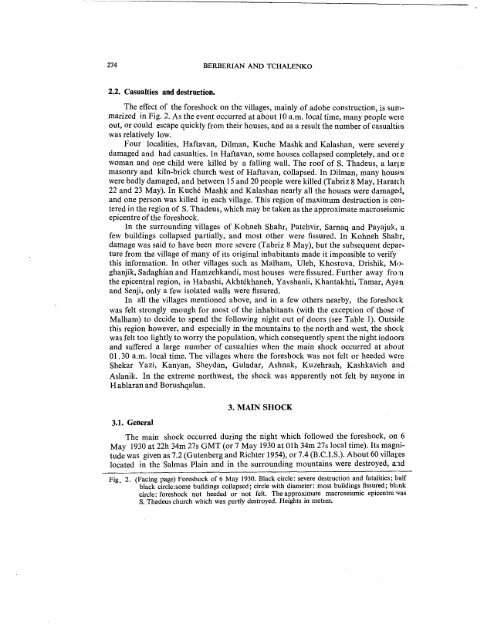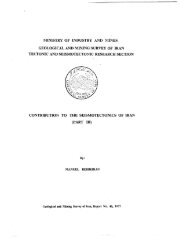You also want an ePaper? Increase the reach of your titles
YUMPU automatically turns print PDFs into web optimized ePapers that Google loves.
274 BERBERIAN AND TCHALENKO2.2. Casualties and destruction.The effect of the foreshock on the villages, mainly of adobe construction, is summarizedin Fig. 2. As the event occurred at about 10 a.m. local time, many people wereout, or could escape quickly from their houses, and as a result the number of casualtieswas relatively low.Four localities, Haftavan, Dilman, Kuche Mashk and Kalashan, were severelydamaged and had casualties. In Haftavan, some houses collapsed completely, and orewoman and one child were killed by. a falling wall. The roof of S. Thadeus, a lary, emasonry and kiln-brick church west of Haflavan, collapsed. In Dilman, many houseswere badly damaged, and between 15 and 20 people were killed (Tabriz 8 May, Haratc:h22 and 23 May). In Kuch6 Mashk and Kalashan nearly all the houses were damaged,and one person was killed in each village. This region of maximum destruction is centeredin the region of S. Thadeus, which may be taken as the approximate macroseismicepicentre of the foreshock.In the surrounding villages of Kohneh Shahr, Patehvir, Sarnaq and Payajuk, afew buildings collapsed partially, and most other were fissured. In Kohneh Shahr,damage was said to have been more severe (Tabriz 8 May), but the subsequent departurefrom the village of many of its original inhabitants made it impossible to verifythis information. In other villages such as Malham, Uleh, Khosrova, Drishik, Moghanjik,Sadaghian and Hamzehkandi, most houses were fissured. Further away fro~aathe epicentral region, in Habashi, Akht6khaneh, Yavshanli, Khantakhti, Tamar, Ayanand Senji, only a few isolated walls were fissured.In all the villages mentioned above, and in a few others nearby, the foreshockwas felt strongly enough for most of the inhabitants (with the exception of those ofMalham) to decide to spend the following night out of doors (see Table 1). Outsidethis region however, and especially in the mountains to the north and west, the shockwas felt too lightly to worry the population, which consequently spent the night indoorsand suffered a large number of casualties when the main shock occurred at aboat01.30 a.m. local time. The villages where the foreshock was not felt or heeded wereShekar Yazi, Kanyan, Sheydan, Guladar, Ashnak, Kuzehrash, Kashkavich audAslanik. In the extreme northwest, the shock was apparently not felt by anyone inH ablaran and Borushqalan.3.1. General3. MAIN SHOCKThe main shock occurred during the night which followed the foreshock, on 6May 1930 at 22h 34m 27s GMT (or 7 May 1930 at 01h 34m 27s local time). Its magnitudewas given as 7.2 (Gutenberg and Richter 1954), or 7.4 (B.C.I.S.). About 60 villa[’,eslocated in the Salmas Plain and in the surrounding mountains were destroyed, a:adFig. 2. (Facing page) Foreshock of 6 May 1930. Black circle: severe destruction and fatalities; halfblack circle :some buildings collapsed; circle with diameter: most buildings fissured; bhmkcircle: foreshock not heeded or not felt. The approximate macroseismic epicentrewasS. Thadeus church which was partly destroyed. Heights in metres.







